As the first of a new breed of hyper hatches to enter the segment, the Audi RS3 8P with 340bhp is a stonking machine from the factory, but that doesn’t mean it’s not still ripe for tuning. With the right modifications you can unleash it’s true potential. Here’s how.
Audi was a late-comer to the hot hatch market, but in 2011, it entered the segment with a bang. It took the ballistic turbocharged 2.5-litre, five-cylinder engine from the TTRS two-seater and slung in into the engine bay of its practical five-door A3. This endowed the hatchback with a whopping 340bhp and 332lb ft of torque, which at the time was considerably more than the then-current kings of the hot hatch scene could muster. Obviously, this was far too much grunt to be put to the tarmac by just the front wheels, so Audi combined it with an advanced Haldex four-wheel-drive system and seamlessly-shifting S-Tronic dual clutch transmission, gifting their new halo model a 0-60mph time of just 4.6 seconds.
Flared front arches made from lightweight carbon reinforced plastic and an aluminium bonnet were added, not only to offset some of the weight of the heavy iron block motor and reduce its propensity to understeer, but also give the hatch a much more muscular aesthetic which was topped off with a deeper and more aggressive front bumper.
This produced a seriously potent package straight out of the box, but tuners were quick to realise that this was merely the tip of the iceberg, and by choosing the right modifications power-hungry owners could easily unleash its true potential, all without adversely affecting its driveability and practicality.
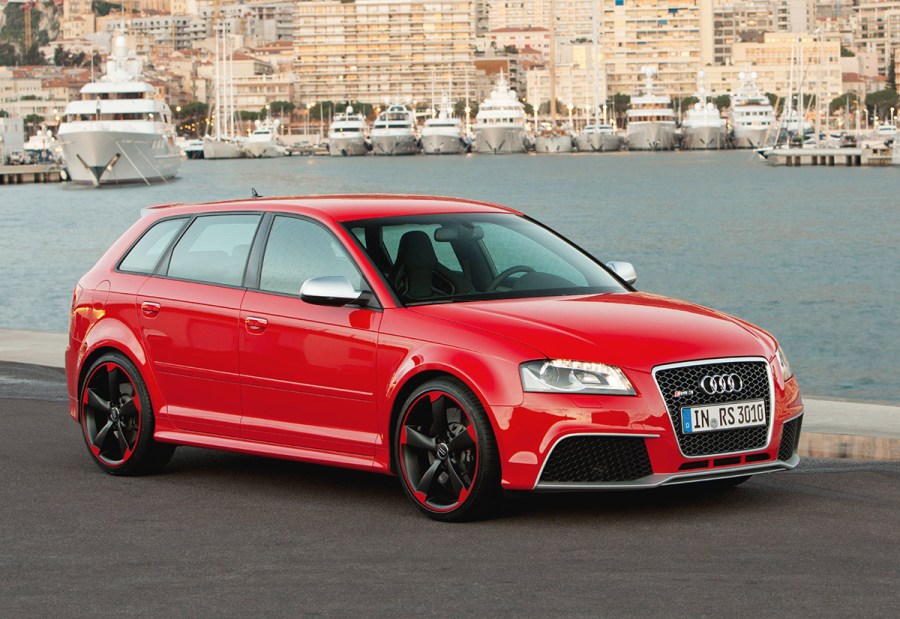
How to tune an Audi RS3 8P
To guide you through the process of tuning your Audi RS3 and ensure you get the biggest bang for your buck, we’ve broken down the car into its component parts to give you specific advice on how to maximise each area. We’ll show you which parts you’ll want to upgrade – as well as which ones work fine from the factory – to let you know the essential areas to spend your cash to get the very best from what is an extremely capable car.
In this guide we’ll focus on the Audi RS3 8P mode, built between 2011 and 2013, but the second generation 8V model is quite similar, so much of the advice may cross-over.
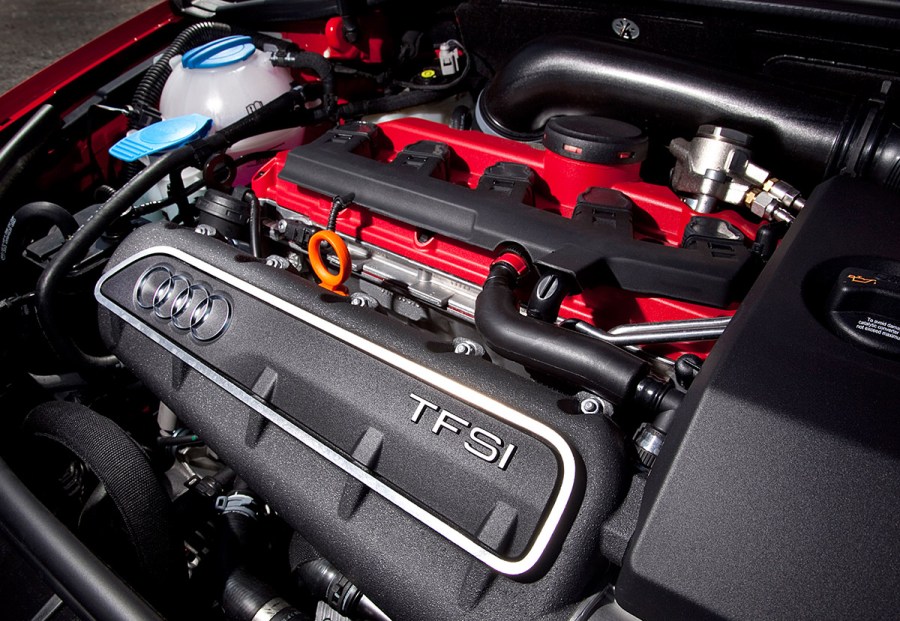
Audi RS3 Engine Tuning
Immensely tuneable, the RS3 8P’s 2.5-litre, five-cylinder CEPA engine has bags of power and torque and throws in an orchestral engine noise as well. It’s iron block is extremely strong and so are the engine’s internals, meaning it can withstand huge boost increases with ease, so few owners feel the need to go changing much when it comes to internals and prefer to spend their cash on bolt on modifications and software updates, as these can yield substantial gains and while retaining excellent reliability.
Saying that, it’s not an engine that’s without issues. Original injectors are known to be troublesome, with tales of them sticking opening and flooding the cylinders with fuel to the point of hydrolocking. Most tuners will ask that these are replaced with much more reliable revised items before attempting even mild upgrades, so prepare to make the switch if they are still originals. Likewise the original coil packs can degrade, reducing spark output and limiting power. Again, a swap to revised items can see a big improvement in performance and economy, if the old ones are past their best.
Finally, the engines are renowned for coking up, so ensure you budget to have the cylinder head fully de-coked before you pursue any tuning, as you could be limiting yourself due to air-flow restrictions caused by this kind of build-up.
Intake Tuning
Engine breathing is at the forefront of all tuning, but the RS3’s standard airbox is actually pretty good, both in terms of air flow and avoiding heat soak, so it’s not essential for power purposes to change it unless you are looking at aiming for over 600bhp, although a freer flowing aftermarket filter element is certainly going to be an improvement. What will improve drastically with an aftermarket intake, however, is the noise.
The RS3’s five-cylinder motor produces one of the best engine sounds around and many owners upgrade the intake just to allow the motor to sing. Options range from relatively cheap, such as the Ramair Jet Stream at around £240, to mid-range such as the Leyo Motorsport kit at just over £600, to the eye-wateringly expensive, such as the 034 Motorsport carbon-fibre cold air intake at just over £1000. How much better one is than the other in terms of their performance is a matter for debate, but many owners opt for the more expensive kit as the carbon pipework is a great cosmetic upgrade to enhance the look of the engine bay.
Exhaust Tuning
A much bigger impact can be had on the RS3’s engine breathing by removing restrictions in the exhaust system. From the factory the 8P comes with three catalytic converters, one primary one in the turbocharger downpipe and two secondary ones in the mid pipe. As you can imagine, these pose quite a prominent restriction to both gas flow and the exhaust note, so removing them can give you large gains in both departments. The cheapest option is to merely delete the two secondary cats, this will release more of that glorious soundtrack, but not too many ponies. The next step up the later would be a freer flowing cat-back exhaust system from the likes of Milltek Sport or Scorpion.
These are available for around £1200 and will give the improved sound and, when combined with the secondary de-cats, will also improve flow, giving a small increase in power. However, the most potent option is definitely to delete the primary cat in the turbo downpipe. These will cost around £750 – £850. This causes the greatest restriction and can release the most power when removed and combined with a suitable Stage 2 remap. This last step is essential when removing the primary cat, as it has lambda sensors before and aft that will throw engine lights if removed without updating the ECU software.
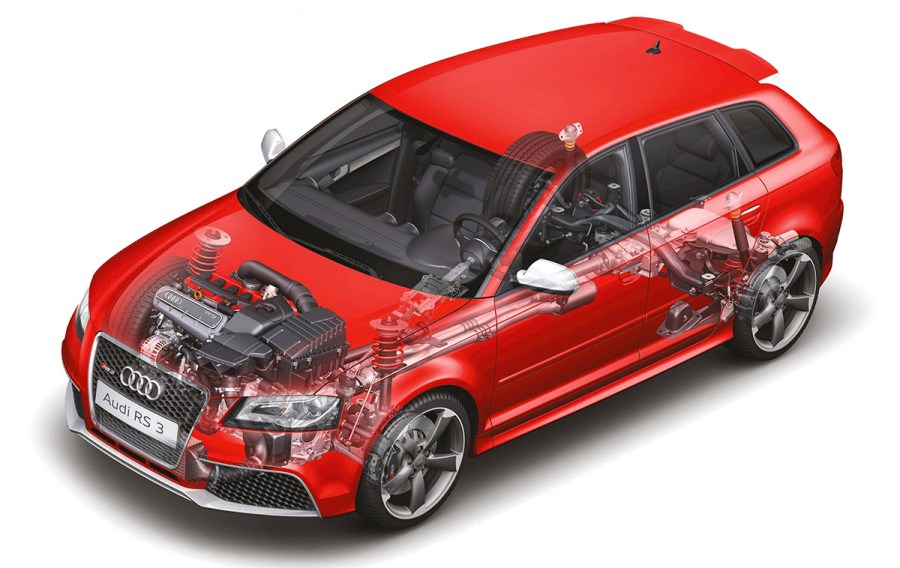
Engine ECU Remapping
Like many modern turbocharged cars, the RS3 responds extremely well to ECU tuning, as experienced tuners can liberate a whole chunk of performance just by plugging a lap top into the standard ECU and crunching the numbers.
Most tuners such as MRC Tuning, APR, Revo and Ecotune offer their remapping services as a series of ‘stages’. Most start at around £550 for stage one, with later stages getting more expensive as the level of complexity and power potential increases.
Although all are subtly different in their approach and specifics, most follow the same pattern of stage one being suitable for a car with standard hardware, stage two is for cars that have the requisite bolt-on modifications to intake, exhaust, fueling and ignition, and stage three is for cars that have all of the above, plus a larger aftermarket turbocharger.
Full standalone ECUs are available for the RS3, but are only necessary if you are building an insane race-level machine that requires the additional functionality and control that only the top level aftermarket ECUs offer. They are also extremely expensive to both purchase, install and setup properly.
Cooling upgrades
Extra boost means the small stock intercooler will start to struggle, so an intercooler upgrade is highly recommended if you are upping the boost considerably, especially if your goal is to achieve more than 400bhp. Gloucester alloy artisans Forge Motorsport are the go to guys here and offer a much larger intercooler in an efficient and free-flowing bar-and-plate design for around £1200. This includes a modified version of the standard Audi crash bar, as the new ‘cooler is simply too big to fit with the original unmodified version. This gives much improved cooling and flow rate allowing more boost to be run while keeping intake temperatures to a minimum. Similar options are also available from Wagner Tuning for a similar price, while Airtec have uprated intercooler options (also complete with modified crash bar) from around £870.
Fueling
The RS3 runs a high pressure fuel pump, but it will start to struggle when boost levels increase and you will notice it topping out why trying to reach the torque figures you are aiming for. A swap to a higher flowing item from the likes of APR will cost around £2500 – £3000 and is necessary for any builds that are running a Stage 3 remap or a big hybrid turbo conversion. The standard injectors are fine when it comes to flow rates, but early original items are known to have problems, including sticking open and flooding the engine, so it’s recommended to swap to later revised items before any tuning takes place, just to be sure they are suitable and flowing correctly.
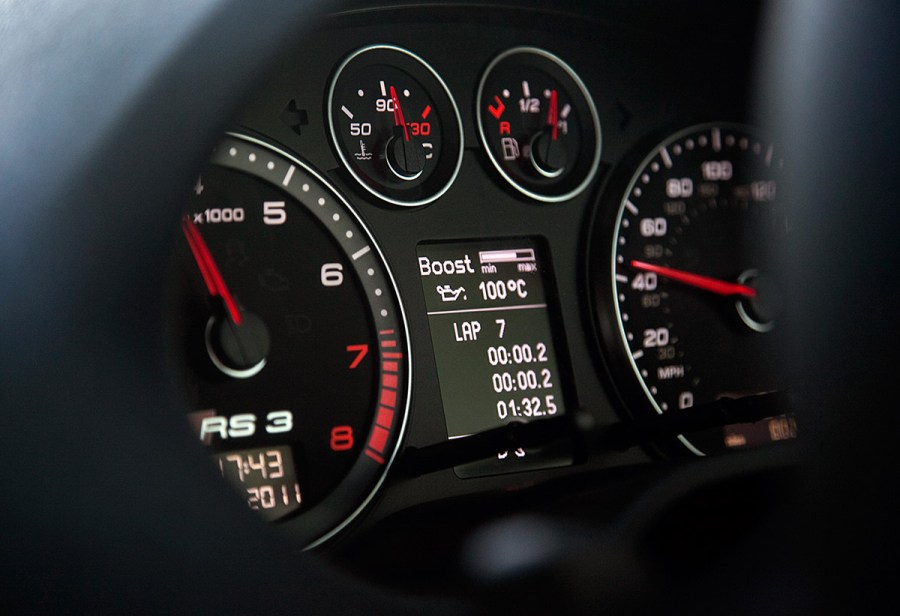
Ignition
The 8P RS3’s standard ignition system is generally decent, however, coilpacks are known to deteriorate, leading to weaker sparks and eventually not delivering either enough voltage to maintain spark integrity at higher boost levels. A swap to a set of revised OEM coilpacks is usually all that is required to ensure smooth running and make a good base for future tuning. A swap to a set of colder grade NGK iridium spark plugs is also often recommended before any serious tuning work commences.
Turbo
The standard RS3 turbocharger is good for up to 440bhp, but, due to their compact size, they struggle to flow enough air to achieve a great deal more. The answer to this dilemma is to bin it and install a £2000 TTE500 turbo. This is based on the original turbine but is home to a much larger TTE compressor wheel, for high efficiency and flow. As the name suggests, this is capable of producing enough boost for over 500bhp when combined with suitable supporting modifications to the fueling, cooling and a Stage 3 remap of the ECU.
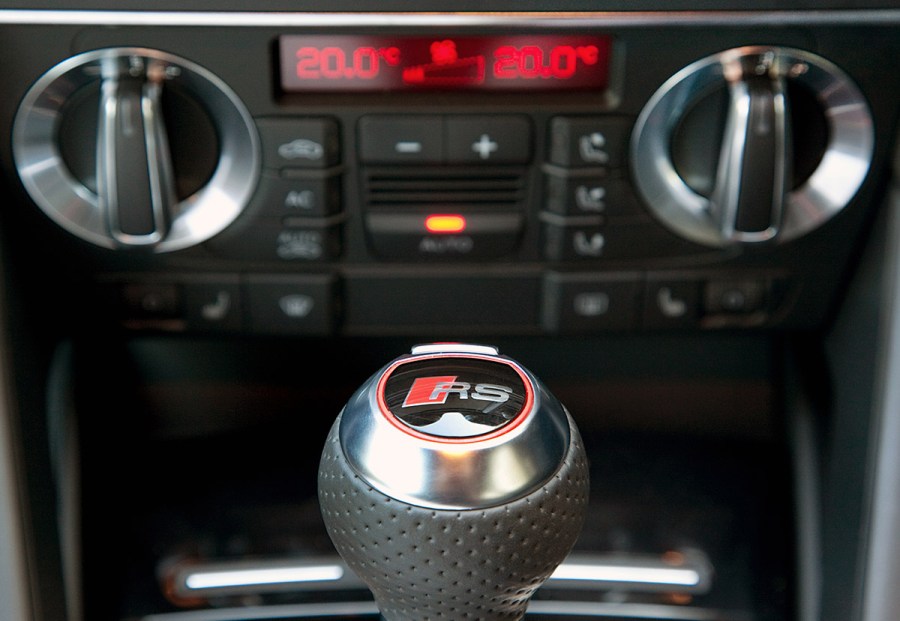
Audi RS3 8P transmission tuning
The RS3’s advanced Haldex four-wheel drive, dual-clutch transmission is a robust unit, with no need for replacement parts to contain even the most audacious power increases. What is worth doing however, is calibrating the gearbox software. This can cost from £350 to £1500 depending on the level of complexity you require, but the results are well worth it, as it will not only allow the gearbox to shift through the ratios much faster, but will also smooth out any jerkiness between shifts and can also increase the clutch plates clamping force, eliminating clutch slip. The software can also give the driver full control of upshifts in manual mode so you can utilise a higher rev range for improved acceleration.
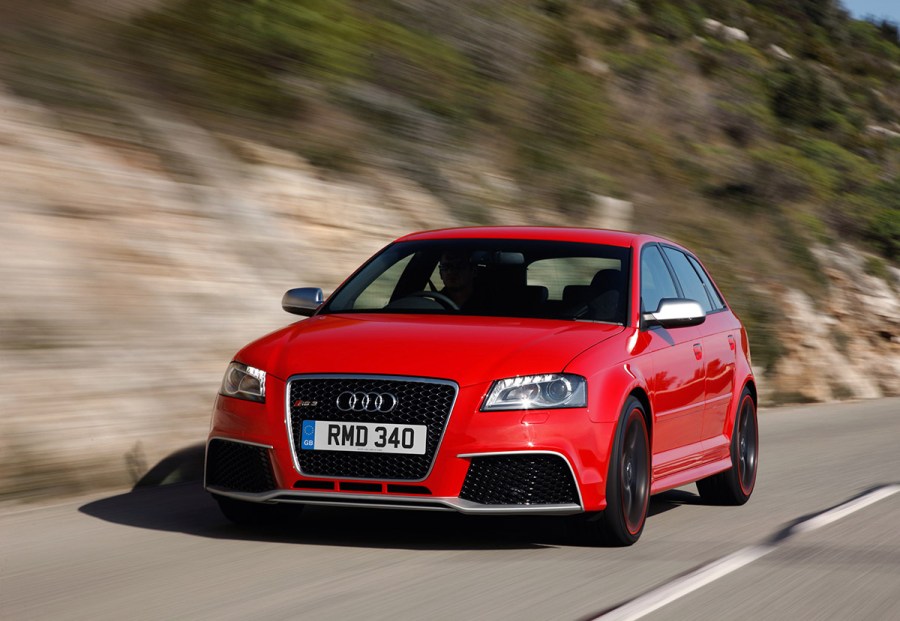
Audi RS3 8P suspension tuning
Audi’s legendary quattro all-wheel drive system is known to produce prodigious grip levels in all conditions, which makes putting down the RS3’s brutal 340bhp a breeze, but its suspension can certainly be improved upon, both in terms of handling and looks.
Springs and dampers
A set of uprated lowering springs and uprated dampers from the likes of Bilstein will not only lower the ride height of your RS3, but it will also lower the centre of gravity and stiffen the suspension too, reducing body roll and improving grip in the corners for around £800. Beyond this, the German suspension gurus have a set of adjustable B16 coilovers available from around £1800 and these will give you even more control, over both the exact ride height and level of damping, allowing you to tailor the car’s handling to your own taste.
Anti-roll bars
Anti-roll bars resist your car’s propensity to body roll. By fitting stiffer items you can increase their effect. For the RS3, its recommended to focus attention at the rear of the car, where an upgraded one from the likes of H&R produces good results for around £190. This should also help reduce the car’s in-built propensity to understeer, giving more neutral handling and improved grip in the corners.
Geometry
Any performance car will benefit from a proper alignment of its suspension geometry and the four-wheel drive RS3 is especially sensitive to this. But don’t just add it on at your local tyre fitters when you have your new tyres fitted, as their equipment is not really set up to get the best out of your modified ride. Your best bet is to go to a specialist who has the equipment and knowledge to dial in custom camber, toe and caster settings to give you the handling you want from your car.
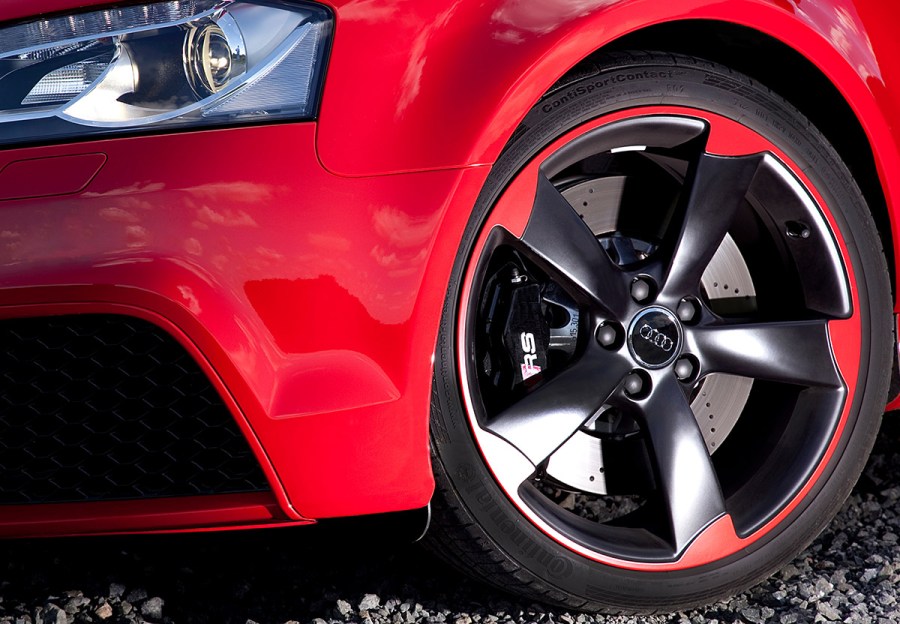
Audi RS3 8P brake tuning
With so much power on tap, it’s not surprising that Audi equipped the RS3 with some mighty stoppers from the factory. But while the meaty four-piston calipers are excellent, the OEM discs and pads are known to squeal like a stuck pig as well as get overwhelmed when used hard on track. A better option for a tuned car packing greater levels of performance is to fit a set of £1500 two-piece floating discs from Vagbrem Technic along with some uprated brake pads such as Ferodo DS2500s or Pagid RS29s.
These will offer much greater bite and stopping power while resisting fade even after prolonged use on track. However, they are likely to produce a higher level of dust, so additional wheel cleaning may be needed to keep your rims looking fresh. If this still isn’t enough, then you can upgrade to a set of calipers from the newer RS3 8V model, which has larger eight piston calipers, or you can choose from a selection of aftermarket big brake kits such as those from TarOx, KSport, Alcon or Brembo. Prices for big brake kits start around £1200 right up to over £3000.
Audi RS3 8P performance wheels and tyres
The 8P RS3 runs huge 8x19in wheels as standard, which while not particularly light, do suit the car’s angular lines well. They run slightly wider rubber at the front than the rear with 235 and 225 section tyres respectively. This is to help reduce the car’s inherent understeer. If you do decide to replace the standard wheels, try and ensure you stick to these staggered tyre sizes and look for replacement wheels that are as light as you can realistically afford; this is because heavy wheels increase the amount of unsprung weight, which will dampen all the good work you have done with your suspension upgrades.
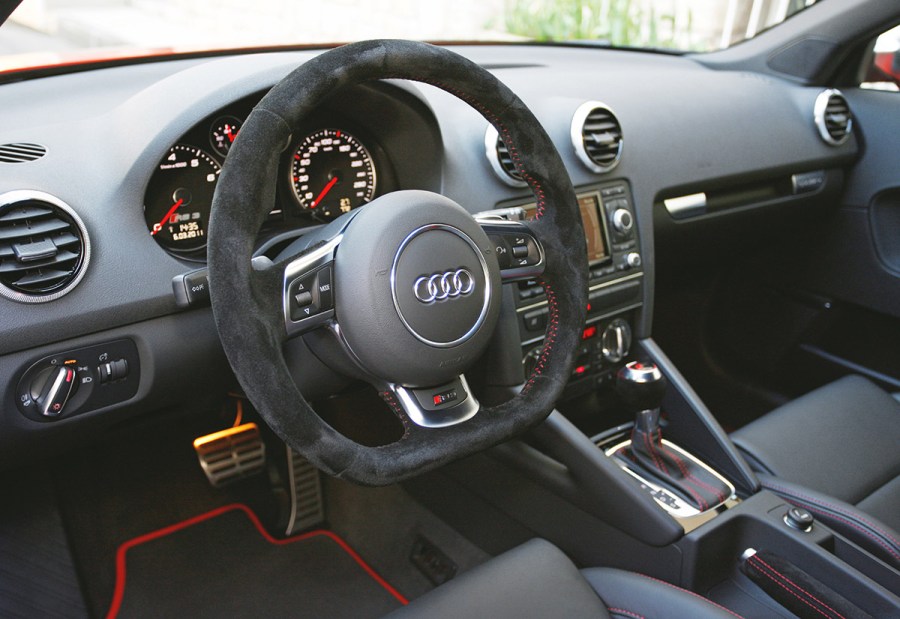
Interior upgrades for the Audi RS3 8P
Audi’s are known for their excellent built quality and lavish, tech-laden interiors and the RS3 is no exception. Some models may have the excellent RS4 bucket seats fitted from the factory, as these were an expensive options from new, but are extremely rare. You could look to carry out the same upgrade yourself if you could find a set on the second-hand market, but even then, don’t expect them to be cheap. Few people tend to go too mad with RS3 interiors, preferring instead to simply retrofit OEM parts from later models to increase the spec but retain a factory look. Other than that, replacing plastic trim with genuine carbon fibre alternatives is always a winner as is having a plush leather and Alcantara retrim in a non-factory colour to really make the interior pop.
Styling upgrades
Similar to the interiors, most RS3 owners don’t stray too far from the look that Audi intended, which is no bad thing to be honest, as they looks pretty tough straight out of the box. However, for those that fancy a little extra aggression there is a host of subtle lips, spoilers and side skirt extensions available from the likes of Maxton Design. These can either be colour coded, painted matt, satin or gloss black or even be made from the lightweight black weave, but these are likely the most expensive option. Finally, if the choice of colours for the RS3 8P seems a little limiting, then why not go for a full vinyl wrap. 3M produce practically any colour you can think of, to give your RS3 a custom look that’ll stand out from any crowd.
Looking to buy an RS3? Be sure to check out our RS3 8P buyers guide for advice.
Words: Dan Sherwood.




